DEADLOCK or double lock all doors whether you are at home or out. Deadlocking the door with a key, bolt, or turn means the door can only be opened from the inside or the outside using the correct key.
Remove the key once you've locked the door to prevent a burglar from reaching through the letterbox or catflap or breaking a window and grabbing your key – but keep it accessible in case of an emergency. On PVCu or composite doors fitted with a multi-point lock, the act of pulling up the door handle or shutting the door will not secure the property - you must also deadlock using a key or turn.
DOORS AND FRAMEWORK
Door security is paramount. Depending on the type of door you have fitted and the materials it is made from, it will likely require a different type of lock. A British Standard (BS) five-lever mortice lock or a BS nightlatch for timber doors is essential for all external doors. A multi-point lock that uses hooks is necessary for PVCu and composite doors. A locksmith approved by the Master Locksmiths Association can specify the most secure door lock standard for any type of door and also fit correctly.
If you're choosing a new door, do your research and make sure that it meets the requirements of British Standard PAS 24. A door tested to this standard will have been put through stringent testing to ensure that the locks, materials, fittings and glass etc withstand the designated 'simulated' burglar attack. If you prefer to install a new timber door, ensure the locks meet BS 3621 for security.
The framework around your doors should be securely fixed and in good condition, otherwise, good doors and locks are useless. All hinges should be fastened with long, good-quality screws, and locks should locate securely into their keeps/door frame when the door is closed.
Check the condition of each door, including its thickness. Some lower door panels are thin material that offers little resistance if attacked. Consider replacing it with a good quality panel or bars fitted to the inside of the door panel and painted the same colour as the door.
LOCKS AND BOLTS
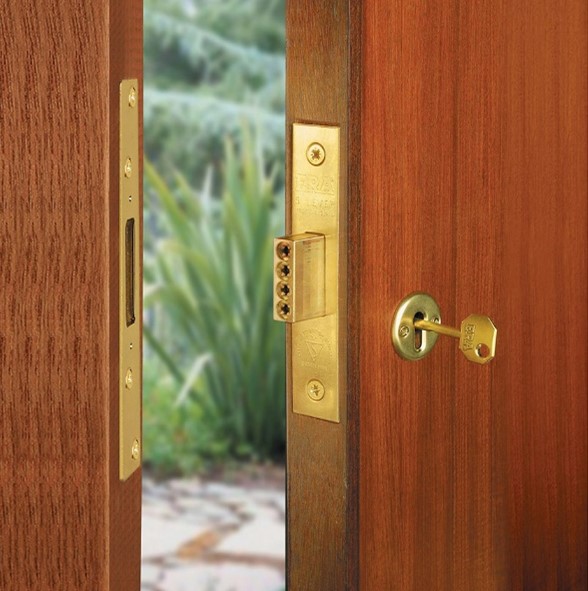
Deadlocks or mortice locks: Mortice locks are physically embedded into a slot in the door for strength. If you have an external timber door, it should be secured with a British Standard 3261 five-lever mortice lock. Look out for the BS Kitemark symbol. Most major insurance companies request these as a requirement for external doors for home contents insurance.
Deadlocks can only be opened with a key, whereas Sashlocks also use a handle. Use a BS Nightlatch with a BS Deadlock to fully secure the doors for added security. Never leave the key in the inside lock, just in case a burglar smashes a panel in the door to reach in and unlock the door.
Nightlatches or rim locks: Nightlatches/rim locks are fitted to the door's surface. They are used primarily as a convenient security latch for front doors. They lock automatically when the door is closed.
They can be opened from the inside without a key and should never be used as the primary lock – you should combine them with a British Standard mortice lock. These locks should be tested to BS 3621 – a minimum insurance requirement.
Automatic deadlocking rim locks are available, which lock automatically and require a key to open from inside and outside.
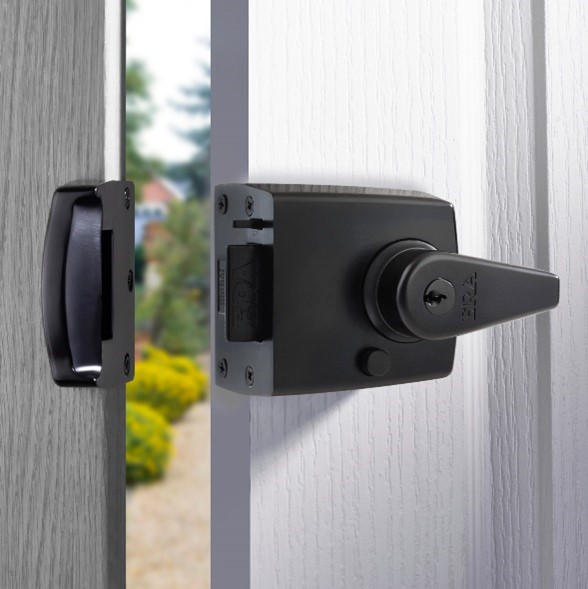
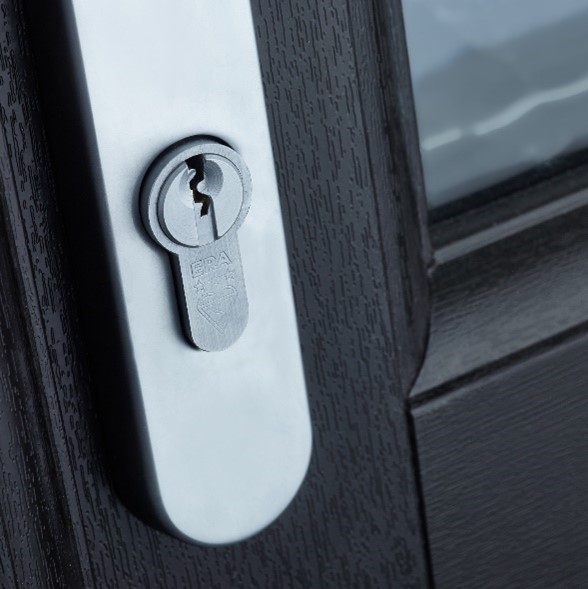
PVCu and composite doors with multi-point locks: If your door is PVCu or composite, it should be fitted with a combination of heavy-duty hooks/bolts/rollers that clamp the door tight against the frame.
Locking cylinders should have a British Standard Kitemark with a TS 007 3-star or Sold Secure Diamond Standard rating. Alternatively, you may fit a 2-star security handle with a 1-star cylinder, which will also equal the maximum 3-star security rating. Always remember to lift the handle, deadlock with the key and remove the key, to fully secure.
Mortice bolts: These bolts operate from the inside of a door and offer robust additional protection. A mortice security bolt is embedded into the door frame and resists forcing and kicking. Even if the burglar breaks the glass, mortice bolts cannot be unbolted. They are excellent on timber French doors, which can be especially vulnerable to burglars.
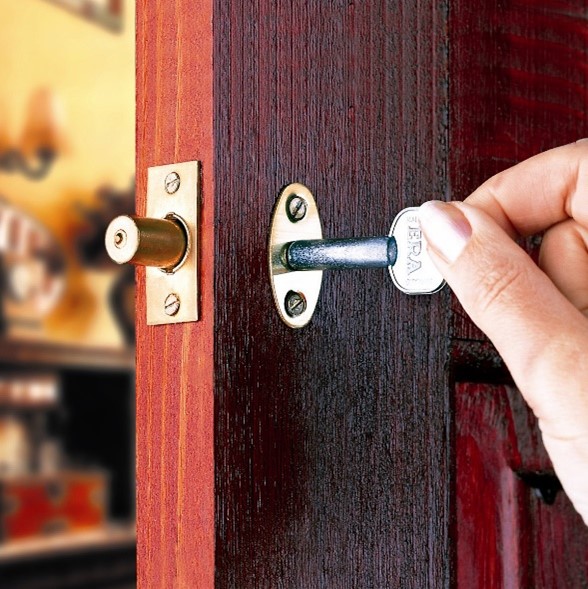
Hinge bolts: Some doors open outwards, and their hinges are exposed and vulnerable to attack. Hinges can be protected by a simple device called a hinge bolt. Typically, one hinge bolt per hinge is recommended. Hinge bolts help protect the hinge side of the door when under attack. Hinge bolts can be considered for all outward opening external doors where hinges are exposed.
FURTHER MEASURES YOU CAN TAKE WITH DOORS
DOOR VIEWERS
A door viewer or spy hole is a device installed in the door at eye level, enabling you to identify callers before opening the door. It allows a wide angle of vision and is usually quite simple to install, needing just one hole drilled in the door. It may also be fitted as part of a door knocker.
DOOR CHAINS AND RESTRICTORS
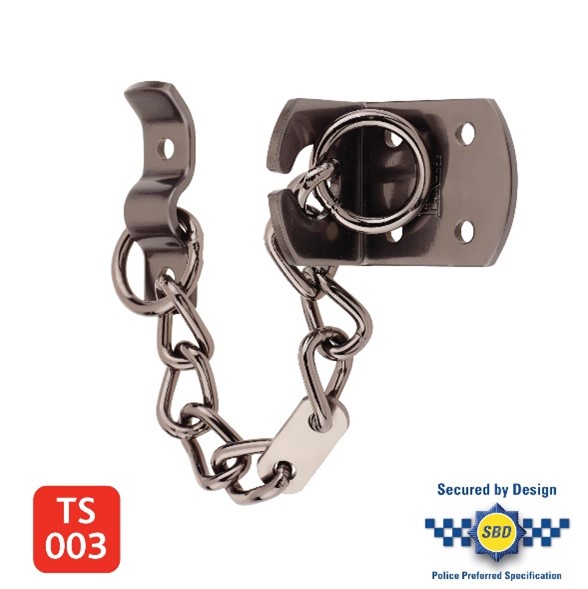
Chains can provide a sense of personal safety, allowing you to check the person on the other side of the door before fully opening the door. Look out for a chain or restrictor that is certified to TS 003 (Secured by Design or similar accreditation).
These heavy-duty products have been independently tested and are supplied with strong fixings.
Don't leave a chain or restrictor on as it could delay your escape in an emergency.
LETTERBOX CAGES AND SECURITY LETTER PLATES
Letterboxes should be at least 40cm from any locks. A letterbox cage can help prevent access to locks. A TS 008 accredited letter plate looks more visually appealing than a cage. It will protect against any unwanted interference through the letter plate to access keys or other belongings.
PATIO AND FRENCH DOORS
Patio doors usually open wide so, once opened, considerable amounts of property can be removed through them. The sliding section of a patio door should be on the inside, not the outside. There are patio doors available that meet the requirements of British Standard PAS 24 for security. If looking for a new door, this is a must. To secure sliding glass panels, at least one, preferably two, patio door locks should be fitted to support the hook lock. If you have an existing patio door, additional bolts can improve current security.
Neighbourhood Watch partner, Patlock, provide a secure device for French doors and conservatories. It is easy to fit and works by holding the internal door handles securely together, meaning the external handles cannot be operated. This ensures that the door mechanism remains locked, even if the locks are snapped or removed. Click here to buy a Patlock at the Neighbourhood Watch exclusive discounted rate of £42.50, with £7.00 donated to the charity’s work.
Another method of entry used by burglars to break through patio or French doors is a spade levered under the bottom rail of the sliding panel. This lifts the door from the bottom channel and pulls the whole door away. Most modern patio doors have an anti-lift device fitted into the door's top channel. This prevents the door from being lifted from the bottom channel if upward pressure is applied. To check whether patio doors can be lifted, open the patio door and, holding the handles, lift the door upwards. If there is excessive movement, an anti-lift device needs to be fitted into the top channel.
The lock on a French door is only as strong as the door itself. Again, depending on the material, French doors are best secured by using a five-lever mortice lock and mortice security bolts, or strong multi-point hooks locks and 3-star cylinders.
GARAGES AND SHEDS
Chances are you will find that three-lever mortice locks are fitted to your rear, side or internal garage doors. These locks are not very secure because they only have the minimum number of possible keys for each model (key 'differs'). The more differs, the more keys a burglar has to carry if they plan to break in that way.
Five-lever mortice deadlocks or sash locks to British Standard 3621 (EN 12209) are much better for the rear, side, and internal garage doors at least 44mm thick. This type of lock is much stronger and more secure, with over 1,000 possible key variations.
One of the first places burglars may look is in sheds, garages or outbuildings. Usually, they are not as securely built as the home and are often located where visibility is poor, making them an easier target. They often contain a ready source of tools for breaking into the main section of the house. Make them just as secure as your home so that any burglar is forced to take more time and make more noise.
CLOSED SHACKLE PADLOCKS
If you cannot adequately secure your outbuildings with mortice locks, use closed shackle padlocks on good-quality hasp and staple or lockable bolts.
Some garages may need additional security as they have internal doors which lead into the house. If you have up-and-over garage doors, you can drill a hole in the top channel above the wheels (from inside the garage) and insert a padlock into the hole. This prevents the wheel from moving above the padlock, so the garage door can't open. Even better, drill a hole in each channel and use two padlocks.
If there is no internal door from the garage to the house, the up-and-over doors can be secured from outside the garage. This is done by welding or bolting an outer bracket and floor eyelet to the bottom of the door and securing it with a padlock inserted into the floor eyelet. To prevent thieves unscrewing the hinges on a garage or shed door and removing the whole door, smear glue over the screw heads or replace them with a type that can't be unscrewed – sometimes called clutch-head, anti-tamper, one-way or coffin screws.
ERA Home Security, our Primary Smart Security Sponsor, provided their expertise to help us create the content and links to their products. There are other products available on the market.
